Absolute Pressure Sensors: The Key to Accurate Measurement
Pressure is a fundamental aspect of our physical world, influencing everything from the weather's twists and turns to the engines propelling us skyward. But in the intricate dance of pressure, one instrument stands out as the silent sentinel, capturing the essence of atmospheric forces with remarkable precision: the absolute pressure transmitter. As an unsung hero of countless industries, this device ensures that altitudes are charted, chemical processes remain controlled, and weather forecasts emerge with uncanny accuracy. In this exploration, we dive deep into the world of absolute pressure transmitters, unraveling their inner workings, illuminating their myriad applications, and revealing the secrets behind their unwavering accuracy. Join us on this journey through the realm of pressure measurement, where precision meets the pressures of our world.
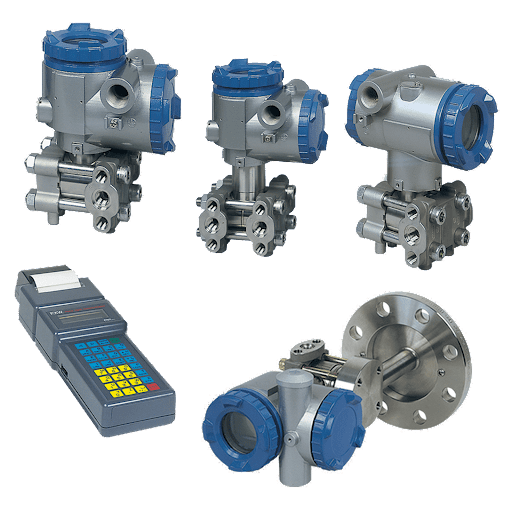
Fig 1. Absolute Pressure Transmitters
What is an Absolute Pressure?
Absolute pressure refers to the total pressure exerted by a fluid (such as a gas or liquid) at a specific point in space, taking into account both the atmospheric pressure and the pressure due to the fluid itself. It is measured relative to a perfect vacuum, where there is no pressure at all. The formula to calculate absolute pressure is:
P_absolute=P_atmospheric+P_gauge
Where:
- P_absolute is the absolute pressure.
- P_atmospheric is the atmospheric pressure, which varies with altitude and environmental conditions.
- P_gauge is the gauge pressure, which is the pressure measured using a gauge relative to atmospheric pressure. If P_gauge is positive, it means the pressure is above atmospheric; if it's negative, it's below atmospheric.
Absolute pressure is important in various fields, including engineering, meteorology, and physics, as it provides a complete understanding of the pressure conditions in a given system or location, regardless of variations in atmospheric pressure.
What is an Absolute Pressure Transmitter?
An Absolute Pressure Transmitter is a specialized sensor or instrument used to measure and transmit the absolute pressure of a fluid or gas within a system. It is designed to provide accurate and continuous monitoring of pressure, taking into account both the pressure exerted by the fluid or gas itself and the atmospheric pressure at the location where the measurement is being made.
Absolute pressure transmitters are commonly used in various industrial and scientific applications where it's essential to know the total pressure, such as in weather monitoring, altitude measurements, vacuum systems, and some manufacturing processes. These transmitters typically provide output signals, often in the form of electrical signals (e.g., 4-20 mA or voltage), that can be used for data acquisition, control systems, or remote monitoring.
By utilizing an Absolute Pressure Transmitter, engineers and researchers can obtain precise pressure data, enabling them to make informed decisions and maintain the safety and efficiency of their systems.
History of Absolute Pressure Transmitters
The history of absolute pressure transmitters is closely tied to the development of pressure measurement technology and the evolving needs of various industries. Here's a brief overview of the key milestones and developments in the history of absolute pressure measurement and the devices that eventually led to absolute pressure transmitters:
Early Pressure Measurement: The concept of measuring pressure dates back centuries, with early devices such as mercury barometers (invented by Evangelista Torricelli in 1643) and manometers used to measure pressure relative to atmospheric pressure. These early devices provided valuable insights into pressure variations.
Industrial Revolution: The Industrial Revolution in the 18th and 19th centuries increased the demand for more precise and versatile pressure measurement instruments. Improvements were made to mercury-based instruments and the development of bourdon tubes (by Eugène Bourdon in 1849) marked a significant advancement.
Electrical Transducers: The mid-20th century saw the development of electrical transducers that could convert mechanical pressure into electrical signals. Strain gauges and piezoelectric sensors allowed for more accurate and convenient pressure measurements. These devices could be used in a variety of applications, including industrial process control and scientific research.
Integration of Electronics: As electronic technology advanced, pressure transducers began to incorporate integrated electronics, enabling the conversion of pressure into electrical signals with improved accuracy and reliability. This laid the foundation for modern pressure transmitters.
Absolute Pressure Transmitters: Absolute pressure transmitters emerged as a specialized category of pressure measurement instruments, designed to measure and transmit pressure relative to a perfect vacuum, taking into account atmospheric pressure variations. These instruments found applications in fields such as meteorology, aviation, and vacuum technology.
Microelectronics and Digital Technology: With the miniaturization of electronic components and the advent of digital technology, absolute pressure transmitters have become more compact and capable of providing digital output signals. This made them suitable for a wider range of applications, including automotive, aerospace, and various industrial processes.
Advancements in Materials and Sensing Technology: Ongoing developments in materials science and sensing technology continue to improve the performance, durability, and accuracy of absolute pressure transmitters. Innovations in microelectromechanical systems (MEMS) have led to even smaller and more cost-effective pressure sensors.
Today, absolute pressure transmitters are an integral part of numerous industries, offering precise and reliable pressure measurement solutions for applications ranging from weather forecasting and aviation to pharmaceutical manufacturing and environmental monitoring. Their evolution continues as technology advances and new materials and methods are developed to enhance their capabilities further.

Fig 2. Absolute pressure sensor
What are the Absolute Pressure Transmitter's internal components?
An absolute pressure transmitter is a complex instrument designed to accurately measure and transmit absolute pressure readings. While specific designs can vary among manufacturers and models, here are the typical internal components you might find in an absolute pressure transmitter:
- Pressure Sensing Element: This is the core component of the transmitter responsible for directly measuring the pressure. The sensing element can take various forms, including:
- Strain Gauge: Strain gauges change resistance when subjected to mechanical deformation, which occurs due to pressure. These changes in resistance are then converted into an electrical signal.
- Piezoelectric Crystal: Piezoelectric materials generate a voltage when subjected to pressure changes. This voltage is proportional to the applied pressure.
- Microelectromechanical System (MEMS) Sensor: MEMS technology involves miniature mechanical structures, often combined with electronics, to detect pressure variations.
- Pressure Isolation Diaphragm: To protect the sensing element from the fluid or gas being measured, there is typically a pressure isolation diaphragm. This diaphragm is in direct contact with the process fluid and transfers the pressure to the sensing element while keeping it isolated from potentially corrosive or damaging substances.
- Electronics: Absolute pressure transmitters include electronic circuitry to process and condition the raw sensor output. This can involve amplification, filtering, and analog-to-digital conversion (ADC) to produce a suitable electrical signal for transmission or further processing. Some advanced transmitters may also have digital signal processing (DSP) capabilities.
- Temperature Compensation: Many absolute pressure transmitters incorporate temperature sensors or compensation circuits to account for temperature variations, which can affect the accuracy of pressure measurements. This ensures that the output remains accurate across a wide temperature range.
- Housing and Enclosure: The internal components are housed within a protective casing or enclosure, which is often designed to withstand harsh environmental conditions. This enclosure also helps maintain the calibration and performance of the transmitter.
- Signal Conditioning and Output Circuitry: Absolute pressure transmitters provide an output signal, typically in the form of a current loop (e.g., 4-20 mA) or a voltage signal. This output can be further conditioned to match the requirements of the receiving system, such as a control room display or a data acquisition system.
- Electrical Connections: Connectors and wiring terminals are provided to facilitate the electrical connection of the transmitter to external equipment.
- Calibration and Compensation Circuitry: Transmitters often include circuitry for calibration and compensation, allowing for adjustment and correction of the output signal to maintain accuracy over time.
- Diagnostic and Communication Interfaces: In some advanced models, diagnostic features and communication interfaces (e.g., HART or digital protocols) are included, enabling remote monitoring, calibration, and troubleshooting.
These components work together to ensure that the absolute pressure transmitter accurately measures the pressure relative to a perfect vacuum and provides a reliable and consistent output signal for various industrial and scientific applications.
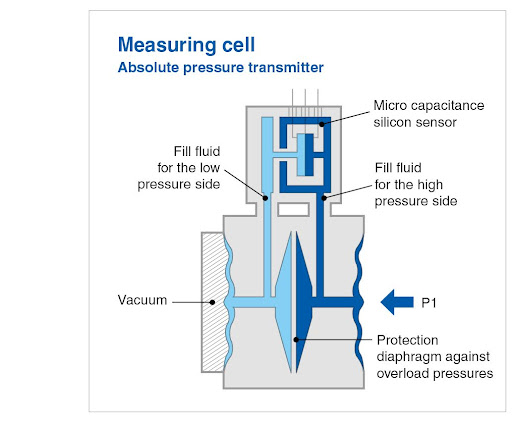
Fig 3. Absolute pressure sensor structure
How does an Absolute Pressure Transmitter work?
An absolute pressure transmitter works by utilizing pressure-sensing elements and electronic components to measure and transmit the absolute pressure of a fluid or gas. Here's a step-by-step explanation of how it works:
- Pressure Sensing: The process begins with the sensing element, which is exposed to the fluid or gas whose pressure needs to be measured. The sensing element is designed to deform or generate an electrical signal in response to the pressure applied to it.
- Pressure Isolation: To protect the sensing element from direct contact with the process fluid and any potential contaminants or corrosive substances, there is often a pressure isolation diaphragm. This diaphragm transmits the pressure to the sensing element while keeping it isolated from the fluid.
- Pressure Measurement: The sensing element reacts to the pressure changes by either changing resistance (in the case of strain gauges), generating a voltage (in the case of piezoelectric crystals), or undergoing mechanical deformation (in the case of MEMS sensors). This response is directly proportional to the absolute pressure applied to the diaphragm.
- Signal Conditioning: The raw signal generated by the sensing element is typically very small and needs to be conditioned for accuracy and stability. Signal conditioning includes amplification, filtering, and often compensation for temperature effects. This stage prepares the signal for further processing.
- Analog-to-Digital Conversion (ADC): In many cases, the analog signal from the conditioning stage is converted into a digital signal using an ADC. This is necessary for compatibility with digital communication protocols and precise numerical representation of the pressure.
- Output Signal: The transmitter produces an output signal that reflects the absolute pressure measurement. Common output signals include 4-20 mA current loops, voltage signals, or digital communication protocols like HART, Profibus, or Foundation Fieldbus. This output signal can be transmitted over long distances to monitoring or control systems.
- Calibration and Compensation: To ensure accuracy, absolute pressure transmitters are typically calibrated during the manufacturing process. Some models also feature compensation circuitry to account for variations in temperature or other environmental factors that may affect the pressure reading.
- Housing and Enclosure: The internal components are enclosed within a protective housing or enclosure, which shields them from external factors like dust, moisture, and physical damage. The design of this housing may vary depending on the intended application and environmental conditions.
- Integration: The absolute pressure transmitter is integrated into the specific system or process where pressure measurement is required. It is connected to the fluid or gas source through appropriate tubing or connections.
- Monitoring and Control: Once installed, the transmitter continuously monitors the absolute pressure and transmits this information to a central control system or display. This data can be used for various purposes, such as process control, safety monitoring, or data logging.
In summary, an absolute pressure transmitter works by using a pressure-sensitive element to convert absolute pressure into an electrical signal. This signal is conditioned, converted to an appropriate output format, and transmitted to external equipment for monitoring and control. It ensures accurate and reliable measurement of absolute pressure, taking into account variations in atmospheric pressure.
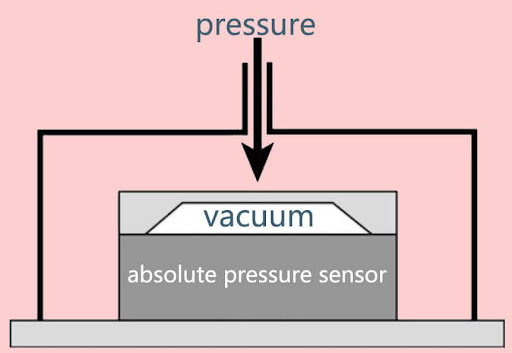
Fig 4. Absolute pressure transmitter operation
What are the Absolute Pressure Transmitter types?
Absolute pressure transmitters come in various types, each designed for specific applications and operating conditions. These types differ based on their sensing technologies, measurement ranges, and suitability for different environments. Here are some common types of absolute pressure transmitters:
Strain Gauge Absolute Pressure Transmitter: These transmitters use strain gauges bonded to a diaphragm or a flexible membrane that deforms under pressure. The strain gauge's resistance changes as the diaphragm flexes, allowing for precise pressure measurement. They are commonly used in industrial applications for their accuracy and reliability.
Piezoelectric Absolute Pressure Transmitter: Piezoelectric transmitters utilize piezoelectric crystals that generate an electrical charge when subjected to pressure changes. This charge is then converted into an electrical signal proportional to the pressure. They are suitable for high-pressure applications and dynamic pressure measurements.
Microelectromechanical Systems (MEMS) Absolute Pressure Transmitter: MEMS technology involves miniature mechanical structures combined with electronics. MEMS absolute pressure transmitters are compact and offer excellent accuracy and stability. They are commonly used in consumer electronics, automotive applications, and some industrial settings.
Capacitive Absolute Pressure Transmitter: Capacitive transmitters rely on changes in capacitance between two conductive plates when subjected to pressure variations. These changes are converted into electrical signals to determine absolute pressure. Capacitive transmitters are used in various industries, including HVAC, automotive, and aerospace.
Resonant Absolute Pressure Transmitter: Resonant transmitters measure pressure by detecting changes in the resonant frequency of a vibrating element, often a quartz crystal, due to pressure variations. They are suitable for high-precision applications, such as laboratory experiments and scientific research.
Digital Absolute Pressure Transmitter: These transmitters provide digital output signals and often feature digital communication protocols such as HART, Profibus, or Foundation Fieldbus. They are used in modern process control and automation systems for easy integration and remote monitoring.
High-Temperature Absolute Pressure Transmitter: Some absolute pressure transmitters are designed to operate reliably in high-temperature environments, such as those found in industrial furnaces, engines, and aerospace applications. They are constructed with materials and components capable of withstanding extreme temperatures.
Sanitary Absolute Pressure Transmitter: Sanitary pressure transmitters are designed for use in hygienic applications, such as the food and pharmaceutical industries. They feature smooth, easy-to-clean surfaces and meet stringent cleanliness and sterility requirements.
Submersible Absolute Pressure Transmitter: Submersible transmitters are designed to operate underwater or in liquid environments, making them suitable for applications such as water level measurement, wastewater monitoring, and marine applications.
Explosion-Proof Absolute Pressure Transmitter: These transmitters are built to be explosion-proof, making them suitable for hazardous environments where the risk of explosion or fire is present. They comply with specific safety standards to ensure safe operation in potentially dangerous settings.
The choice of absolute pressure transmitter type depends on factors like the application's pressure range, temperature, environmental conditions, and the required level of accuracy and reliability. Selecting the appropriate type ensures that the transmitter meets the specific needs of the intended application.
Strain Gauge Absolute Pressure Transmitter:
Piezoelectric Absolute Pressure Transmitter:
Microelectromechanical Systems (MEMS) Absolute Pressure Transmitter:
Capacitive Absolute Pressure Transmitter:
Resonant Absolute Pressure Transmitter:
Digital Absolute Pressure Transmitter:
High-Temperature Absolute Pressure Transmitter:
Sanitary Absolute Pressure Transmitter:
Submersible Absolute Pressure Transmitter:
Explosion-Proof Absolute Pressure Transmitter:
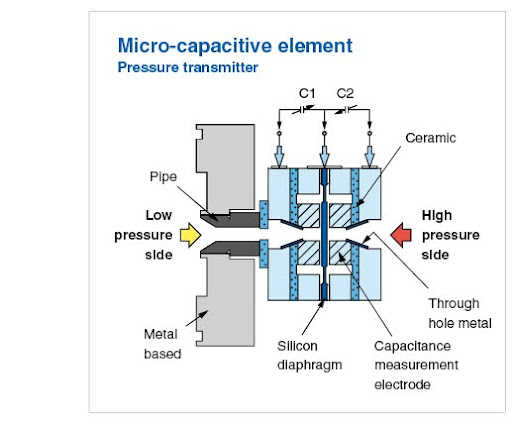
Fig 5. Capacitive absolute pressure transmitter
Comparing table
Certainly! Here's a comparison table summarizing the key characteristics, operation, applications, and pros and cons of each type of absolute pressure transmitter:
| Type of Absolute Pressure Transmitter | Description | Operation | Applications | Pros | Cons |
| Strain Gauge Absolute Pressure Transmitter | Uses strain gauges on a diaphragm to measure pressure | Change in resistance of strain gauges due to diaphragm flexing | Industrial process control, gas distribution systems | High accuracy, reliability, wide pressure range | Sensitive to mechanical shock and vibration |
| Piezoelectric Absolute Pressure Transmitter | Utilizes piezoelectric crystals to generate voltage in response to pressure | Piezoelectric crystal generates a voltage proportional to the pressure | Automotive engine monitoring, hydraulic systems | Excellent sensitivity, fast response time | Sensitive to temperature variations |
| MEMS Absolute Pressure Transmitter | Combines miniature mechanical structures with electronics on a silicon chip | Pressure-induced changes in MEMS diaphragm alter capacitance or resistance | Consumer electronics, HVAC, automotive | Compact size, low power consumption | Limited to moderate pressure ranges |
| Capacitive Absolute Pressure Transmitter | Measures pressure by changes in capacitance between two plates | Pressure-induced changes in gap alter capacitance | HVAC, tire pressure monitoring, moderate-accuracy industrial applications | Good linearity, relatively low cost | Limited accuracy for high-pressure ranges, humidity-sensitive |
| Resonant Absolute Pressure Transmitter | Detects changes in resonance frequency of a vibrating element (e.g., quartz crystal) | Pressure changes affect the crystal resonance frequency | Laboratory experiments, scientific research | measurementsccuracy, stability, precision | Higher cost, limited to low-pressure ranges |
| Digital Absolute Pressure Transmitter | Provides digital output and supports digital communication protocols | Converts pressure into digital format | Process control, automation systems | Easy integration with digital systems, remote monitoring | Potentially costlier than analog models |
| High-Temperature Absolute Pressure Transmitter | Designed to withstand extreme temperature conditions | Operates similarly to standard transmitters with high-temperature materials | Industrial furnaces, aerospace, engine monitoring | Resistant to extreme temperatures | Typically more expensive |
| Sanitary Absolute Pressure Transmitter | Designed for hygienic applications with smooth surfaces | Operates similarly to standard transmitters with hygiene compliance | Food and pharmaceutical industries | Hygiene compliance, easy to clean | Limited use in non-sanitary applications |
| Submersible Absolute Pressure Transmitter | Designed for operation underwater or in liquid environments | Operates similarly to standard transmitters with submersible design | Water level measurement, marine applications | Accurate measurements in submerged conditions, moisture-resistant | Limited to liquid pressure measurement applications |
| Explosion-Proof Absolute Pressure Transmitter | Designed for safe operation in hazardous environments | Operates similarly to standard transmitters with added safety features | Oil and gas, chemical processing, mining | Ensures safety in hazardous locations, safety compliant | Typically more expensive |
Please note that the choice of absolute pressure transmitter type should be based on the specific needs and requirements of the application, taking into consideration factors such as pressure range, temperature, accuracy, and environmental conditions.
What is the Absolute Pressure Transmitter usage?
Absolute pressure transmitters have a wide range of applications across various industries where precise measurement of absolute pressure is essential. Some common uses of absolute pressure transmitters include
Installation and Maintenance
How can use the Absolute Pressure Transmitter?
Using an absolute pressure transmitter involves several key steps to ensure accurate and reliable pressure measurements. Here's a guide on how to use an absolute pressure transmitter:
- Select the Appropriate Transmitter Type: Begin by choosing the right type of absolute pressure transmitter for your specific application. Consider factors such as the pressure range, temperature conditions, and the environment in which the transmitter will operate.
- Installation: Proper installation is crucial for accurate measurements. Ensure that the transmitter is securely and appropriately mounted, with the pressure isolation diaphragm exposed to the fluid or gas whose pressure you want to measure. Follow the manufacturer's guidelines for installation, including any required sealing or gasket materials.
- Electrical Connections: Connect the transmitter's electrical leads or terminals to the appropriate monitoring or control system. Make sure the connections are secure and correctly wired, adhering to safety and wiring standards.
- Calibration: Before putting the absolute pressure transmitter into service, it should be calibrated to ensure accurate measurements. This typically involves comparing the transmitter's output signal to a reference standard under known pressure conditions. The calibration process may require specialized equipment and expertise.
- Zero Adjustment: Some transmitters have a zero adjustment feature that allows you to set the output signal to a specific value when there is no pressure applied. This step helps compensate for any offset in the transmitter's output.
- Testing and Verification: Conduct testing and verification procedures to confirm that the transmitter is functioning correctly. This may include applying known pressure values and confirming that the transmitter's output corresponds accurately to these values.
- Monitoring and Data Acquisition: Once the transmitter is operational, it continuously monitors the absolute pressure and converts it into an electrical signal, such as a 4-20 mA current or a voltage signal. This signal can be transmitted to monitoring equipment, a control room, or data acquisition systems for further analysis and action.
- Maintenance and Periodic Calibration: Regular maintenance is essential to ensure the continued accuracy and reliability of the absolute pressure transmitter. Depending on the application, it may be necessary to recalibrate the transmitter periodically. Maintenance tasks may also include checking for physical damage, cleaning, and verifying electrical connections.
- Safety Considerations: In some applications, where safety is a concern, absolute pressure transmitters may be used in conjunction with safety interlocks or alarm systems to ensure that pressure levels stay within safe operating limits.
- Remote Monitoring and Integration: If the transmitter supports digital communication protocols (e.g., HART, Profibus, or Foundation Fieldbus), it can be integrated into a networked system for remote monitoring and control. This allows for real-time data access and the ability to make adjustments or take action remotely.
- Record Keeping: Maintain detailed records of calibration, maintenance, and any issues or irregularities encountered during the transmitter's operation. These records can be valuable for quality control, compliance, and troubleshooting.
Using an absolute pressure transmitter effectively involves careful selection, proper installation, calibration, ongoing maintenance, and adherence to safety procedures. By following these steps and considering the specific requirements of your application, you can ensure that the transmitter provides accurate and reliable pressure measurements for your intended purpose.
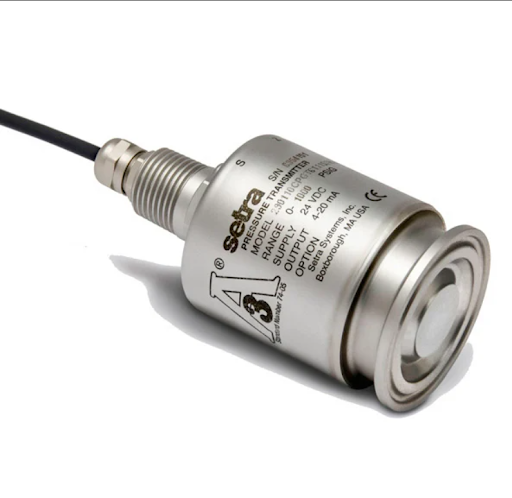
Fig 6. Sanitary pressure sensor
Absolute Pressure Transmitter Calibration
Calibrating an absolute pressure transmitter is a critical process that ensures its accuracy and reliability in providing precise pressure measurements. Calibration involves comparing the transmitter's output signal to a known, traceable reference standard under controlled conditions. During calibration, various pressure points within the transmitter's specified range are applied, and the corresponding output signals are recorded. Any discrepancies between the transmitter's readings and the reference values are noted, and necessary adjustments are made to align the transmitter's output with the reference data. Calibration may require specialized equipment, a controlled environment, and skilled technicians. It is typically performed at regular intervals, following manufacturer recommendations or industry standards, to maintain the transmitter's accuracy over time. Calibration records are kept to document the process and demonstrate compliance with quality and safety standards, ensuring that the absolute pressure transmitter continues to provide dependable measurements in various applications.
Absolute Pressure Transmitter Accuracy
Accuracy in the context of an absolute pressure transmitter refers to how closely the measurements taken by the transmitter match the actual pressure values in the environment being measured. It is a critical parameter because accurate pressure data is essential in various applications where safety, quality control, and process optimization are paramount. Here's an explanation of the factors that contribute to the accuracy of an absolute pressure transmitter:
- Sensor Calibration: The accuracy of an absolute pressure transmitter is heavily dependent on the calibration of its pressure sensor. During calibration, the transmitter is compared against a known, traceable standard to determine any discrepancies in its output. Calibration ensures that the transmitter's readings are as close as possible to the true pressure values.
- Linearity: Linearity refers to how well the transmitter's output signal follows a straight line when graphed against the actual pressure values. A perfectly linear transmitter would produce a perfectly straight line on such a graph. Non-linearity can introduce errors in pressure measurements, especially at extreme ends of the pressure range.
- Hysteresis: Hysteresis is the difference in measurements when the same pressure is applied consecutively, first increasing and then decreasing. An accurate transmitter should exhibit minimal hysteresis, meaning that its measurements are consistent regardless of whether the pressure is rising or falling.
- Repeatability: Repeatability is the ability of the transmitter to produce consistent measurements when the same pressure is applied multiple times under the same conditions. A highly repeatable transmitter will consistently reproduce the same output for a given pressure value.
- Temperature Effects: Temperature variations can affect the accuracy of absolute pressure transmitters. Most transmitters are equipped with temperature compensation circuitry to minimize errors caused by temperature changes. However, the degree of compensation varies among models, and extreme temperature fluctuations may still impact accuracy.
- Environmental Conditions: The conditions in which the transmitter operates, such as humidity, altitude, and exposure to corrosive substances, can influence its accuracy. Specialized transmitters may be required to address specific environmental challenges.
- Manufacturing Quality: The precision and quality of the manufacturing process play a significant role in determining a transmitter's accuracy. Quality control measures, including materials, assembly, and testing, are essential for producing accurate instruments.
- Aging and Wear: Over time, absolute pressure transmitters may experience wear or aging, which can affect their accuracy. Regular maintenance and recalibration are necessary to address these issues and maintain accuracy.
- Calibration Interval: The frequency of recalibration can impact accuracy. More critical applications may require more frequent calibration to ensure the highest level of precision.
It's important to note that the stated accuracy of a transmitter, typically provided by the manufacturer, represents the best-case scenario under ideal conditions. Real-world performance can vary depending on factors such as installation, environmental conditions, and wear and tear. Regular calibration and maintenance are essential practices to maintain and verify the accuracy of absolute pressure transmitters in practical applications.
What are the advantages and disadvantages of an Absolute Pressure Transmitter?
Absolute pressure transmitters offer numerous advantages, but they also come with certain limitations and disadvantages. Here's a summary of both:
Advantages:
Disadvantages:
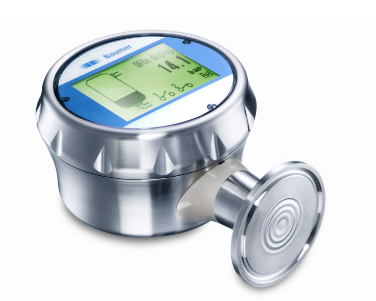
Fig 7. Hygienic absolute pressure sensor
How can choose the proper Absolute Pressure Transmitter?
Choosing the proper absolute pressure transmitter for your specific application requires careful consideration of various factors to ensure accurate and reliable pressure measurements. Here are steps to help you make the right choice:
Determine Your Application Requirements:
- Identify the pressure range: Determine the minimum and maximum pressure values you need to measure. Ensure that the transmitter's range covers your application's operating pressure.
- Consider the medium: Specify whether you are measuring gases, liquids, or both, and take into account the compatibility of the transmitter with the medium's properties and potential corrosiveness.
Environmental Conditions:
- Assess the operating environment: Consider factors such as temperature, humidity, and exposure to corrosive substances. Choose a transmitter that can withstand these conditions.
- Check for hazardous locations: If your application involves potentially explosive atmospheres, select an explosion-proof or intrinsically safe transmitter that complies with safety standards.
Accuracy and Precision:
- Determine the required accuracy: Assess how critical accuracy is for your application. Higher accuracy transmitters may be necessary for precision-critical processes, while lower accuracy models may suffice for less critical applications.
- Consider linearity, hysteresis, and repeatability: Review specifications related to linearity (how closely the output follows a straight line), hysteresis (measurement variation during pressure cycles), and repeatability (consistency in repeated measurements). These factors affect accuracy.
Output Signal and Communication:
- Decide on the output signal: Choose between analog signals (e.g., 4-20 mA or voltage) or digital communication protocols (e.g., HART, Profibus, or Foundation Fieldbus) based on compatibility with your control and monitoring systems.
- Evaluate remote monitoring needs: If remote monitoring and diagnostics are essential, opt for a transmitter with digital communication capabilities.
Physical Design and Mounting:
- Consider size and mounting options: Ensure that the transmitter's physical dimensions and mounting options align with your installation requirements and available space.
- Evaluate enclosure requirements: Determine if the transmitter needs protection from environmental factors, such as weatherproof or explosion-proof enclosures.
Calibration and Maintenance:
- Assess calibration needs: Consider how often the transmitter will need calibration based on your application's criticality and the manufacturer's recommendations.
- Evaluate maintenance requirements: Review the transmitter's maintenance needs, including sensor replacement, and factor these into your decision.
Budget and Cost of Ownership:
- Establish a budget: Determine the budget available for the absolute pressure transmitter, considering both the initial purchase price and ongoing costs like calibration and maintenance.
- Consider long-term costs: Evaluate the cost of ownership over the transmitter's expected lifespan, including factors like calibration, maintenance, and potential replacements.
Manufacturer and Quality:
- Research manufacturers: Choose reputable manufacturers known for producing high-quality, reliable instruments.
- Review product specifications and datasheets: Thoroughly review the technical specifications and datasheets provided by the manufacturer to ensure they meet your requirements.
Consult with Experts:
- Seek advice from experts: Consult with engineers, technicians, or specialists in your field who have experience with similar applications and instrumentation.
Documentation and Support:
- Ensure that the manufacturer provides comprehensive documentation, including user manuals and technical support. Good support can be invaluable in resolving issues and ensuring optimal performance.
Compliance and Certification:
- Ensure that the transmitter complies with relevant industry standards and certifications, especially if your application requires specific regulatory compliance.
Feedback and Reviews:
- Read user reviews and seek feedback from peers or colleagues who have used similar transmitters in similar applications.
By carefully considering these factors and conducting thorough research, you can choose the proper absolute pressure transmitter that meets your application's requirements and provides accurate, reliable, and cost-effective pressure measurements.
Top brands of Absolute Pressure Transmitters
Several reputable brands are known for producing high-quality absolute pressure transmitters. These brands are well-regarded in the industry for their reliability, accuracy, and durability. Here are some top brands of absolute pressure transmitters:
Conclusion
In conclusion, absolute pressure transmitters are essential instruments used across a wide range of industries and applications to measure pressure relative to a perfect vacuum. They play a crucial role in ensuring safety, quality control, and process optimization. Choosing the right absolute pressure transmitter involves careful consideration of factors such as pressure range, accuracy, environmental conditions, and budget. Reputable brands like Rosemount, Siemens, Endress+Hauser, ABB, and others offer high-quality transmitters known for their reliability and performance. Regular calibration, maintenance, and adherence to safety standards are essential to maximize the accuracy and longevity of these instruments. Whether in aerospace, industrial processes, meteorology, or any other field, the proper selection and use of absolute pressure transmitters contribute to safer, more efficient, and more accurate operations.
To recap
1.What is an absolute pressure transmitter?
An absolute pressure transmitter is a device used to measure pressure relative to a perfect vacuum, providing readings that account for atmospheric pressure. It is essential for applications where precise pressure measurements are required.
2.How does an absolute pressure transmitter differ from a gauge pressure transmitter?
An absolute pressure transmitter measures pressure relative to a vacuum, while a gauge pressure transmitter measures pressure relative to the local atmospheric pressure. Absolute pressure readings include the effects of atmospheric pressure, while gauge pressure readings do not.
3.What are the common applications of absolute pressure transmitters?
Absolute pressure transmitters are used in meteorology, aerospace, industrial process control, altitude measurement, vacuum systems, and various other applications where accurate pressure data is critical.
4.How do I choose the right absolute pressure transmitter for my application?
Choose a transmitter based on factors such as pressure range, accuracy, environmental conditions, and communication requirements. Consult with experts and consider reputable brands known for quality.
5.What is the accuracy of absolute pressure transmitters?
The accuracy of absolute pressure transmitters varies depending on the model and manufacturer. Accuracy levels can range from less than 1% to higher levels, with the choice depending on the application's precision requirements.
6.Do absolute pressure transmitters require calibration?
Yes, absolute pressure transmitters require periodic calibration to maintain accuracy. The frequency of calibration depends on the application and manufacturer recommendations.
7.Can absolute pressure transmitters operate in hazardous environments?
Yes, some models are designed for hazardous locations and are available in explosion-proof or intrinsically safe configurations to ensure safety in potentially explosive atmospheres.
8.What are the main factors that can affect the accuracy of an absolute pressure transmitter?
Factors include temperature variations, linearity, hysteresis, repeatability, environmental conditions, and wear and tear over time. Proper installation and maintenance are essential to mitigate these effects.
9.Are there digital absolute pressure transmitters available?
Yes, many absolute pressure transmitters offer digital output signals and support digital communication protocols (e.g., HART, Profibus) for integration into modern control and monitoring systems.
10.Can absolute pressure transmitters be used for liquid pressure measurements?
Yes, absolute pressure transmitters can be used to measure the pressure of liquids, provided they are compatible with the medium and are designed for the required pressure range.
References
https://www.fujielectric.fr/en/product/absolute-pressure-transmitter
https://www.hitma-instrumentatie.nl/en/products/foxboro-absolute-pressure-transmitter-series-iap05s
https://www.transmittershop.com/product-category/transmitters/absolute-pressure-transmitters/
https://www.eastsensor.com/blog/absolute-pressure-sensors/
https://americas.fujielectric.com/products/instrumentation/pressure/
https://www.omega.com/en-us/pressure-measurement/pressure-transducers/p/PX3005
https://realpars.com/pressure-transmitter/
https://www.setra.com/products/pressure/model-290-sanitary-pressure-transducer
Recent Posts
-
Booster Pump Troubleshooting and Maintenance: How to Fix and Prevent Common Issues
1. Introduction Imagine turning on your faucet only to be greeted with a weak trickle of water when …22nd Apr 2025 -
Energy-Efficient Booster Pumps: Selection and Tips for Maximizing Performance
1. Introduction Imagine never having to deal with fluctuating water pressure, noisy pumps, or skyroc …19th Apr 2025 -
Booster Pumps for Sustainable Water Systems: Irrigation and Rainwater Harvesting Solutions
1. Introduction Water scarcity is no longer a distant threat—it’s a reality affecti …16th Apr 2025




